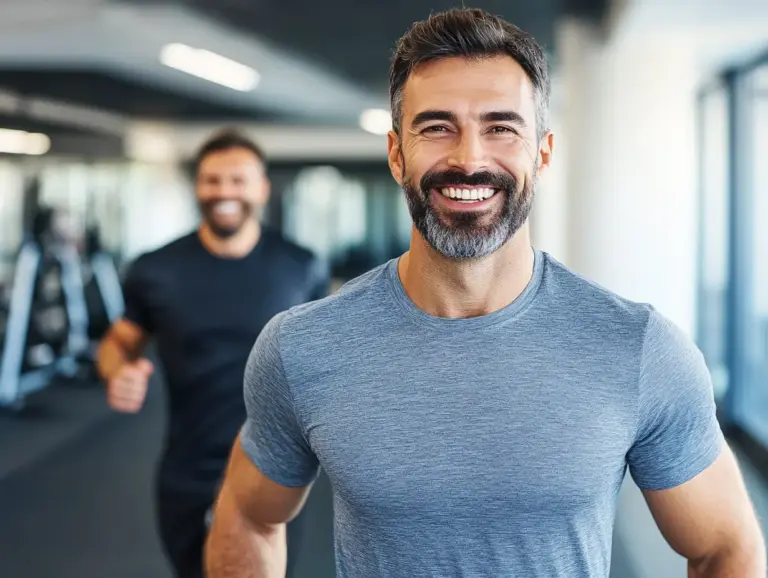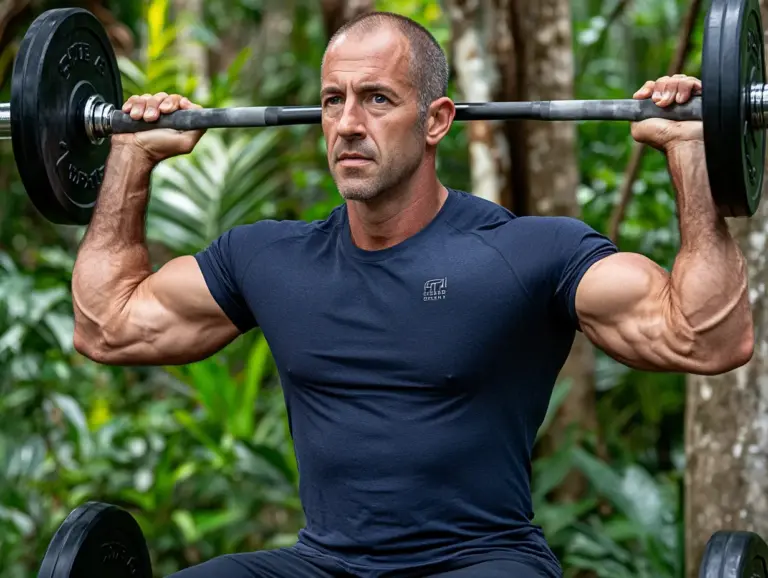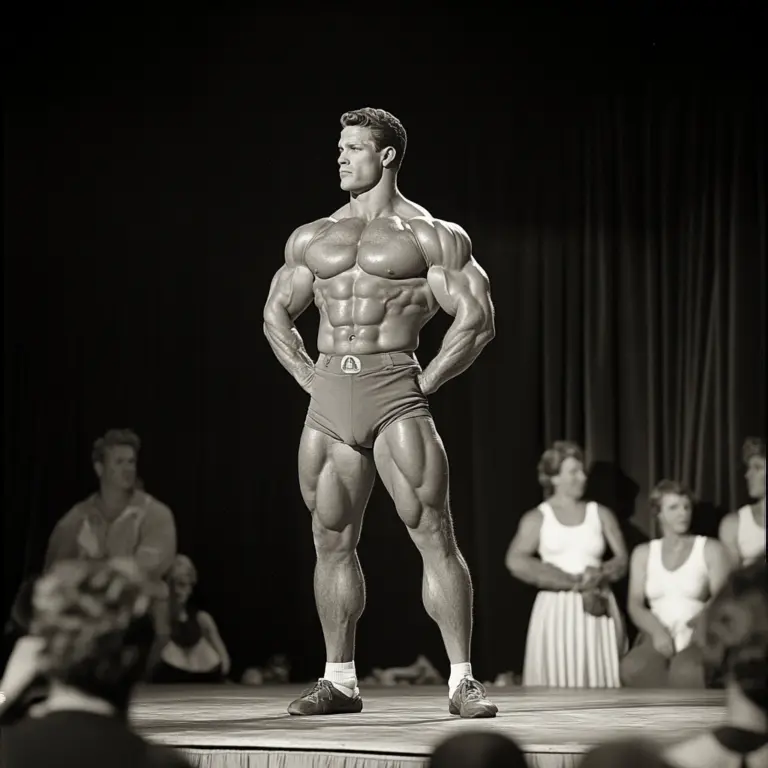HIIT Over 50: A 20-Minute, Low-Impact Workout for Beginners
HIIT Over 50: A 20-Minute, Low-Impact Workout for Beginners Stepping…
HIIT Over 50: A 20-Minute, Low-Impact Workout for Beginners
Stepping into fitness after 50 is a transformative journey that can enhance your overall health, vitality, and quality of life. HIIT (High-Intensity Interval Training) is not just for the young—it’s a powerful, adaptable workout method suitable for all ages and fitness levels. However, despite its name, this workout should not be high intensity for first-time seniors, at least not during the initial sessions. It’s important to build up intensity, speed, and duration over time to ensure safety and enjoyment. This comprehensive guide introduces a HIIT workout for beginners over 50, focusing on low-impact, full-body exercises that are gentle on the joints while effectively increasing your fitness level, encouraging muscle retention and burn calories.
By acknowledging that the intensity should be adjusted for beginners, especially seniors new to HIIT, and starting with bodyweight exercises to condition the body and muscles, we make the workout more approachable and safer. Incorporating low-intensity intervals initially is important to help the body adapt and build a solid foundation before progressing to more challenging movements. This also sets realistic expectations and encourages gradual progression, which is key for long-term success.
Table of Contents
-
Why HIIT After 50?
-
Preparation For Your Workouts
-
Understanding HIIT
-
Benefits of HIIT Workouts for Over 50
-
Starting Your Fitness Journey
-
Warm-Up: Preparing Your Body
-
The 20-Minute Low-Impact HIIT Workout
-
Workout Structure
-
Exercise Descriptions
-
-
Cool-Down: Recovering Properly for Cardiovascular Health
-
Nutritional Tips for Optimal Health
-
Incorporating HIIT into Your Fitness Routine
-
Tracking Your Progress
-
Setting Realistic Fitness Goals
-
Addressing Common Challenges
-
Additional Motivational Tips
-
Tips for Preventing Injuries
-
Benefits of Group vs. Solo Workouts
-
Incorporating Mental Health Practices
-
Creating a Safe Workout Environment
-
Future Workouts: Advancing Your HIIT Training
-
Progressing at Your Own Pace
-
Final Thoughts
-
Ready for a Personalized Plan?
-
Disclaimer
Why HIIT After 50?
As we age, maintaining an active lifestyle becomes increasingly important for preserving muscle mass, cardiovascular health, and overall well-being. So what’s the best HIIT for you? HIIT workouts involve short bursts of high-intensity exercises followed by rest periods, making them efficient and effective for improving fitness levels whilst encouraging your body to burn fat before moving to a more advanced HIIT workout.
Muscle Mass and Aging
-
Sarcopenia: After 30, adults can lose up to 1% of muscle mass per year if inactive. A HIIT workout play a major role in suppressing sarcopenia by engaging multiple muscle groups and enhancing overall muscular endurance and strength. Starting with beginner HIIT workouts ensures that individuals can slowly build their muscle capacity.
-
Fast-Twitch Muscle Fibers: These fibers, crucial for speed and power, decline with age. HIIT exercise help engage these fibers, providing the stimulus needed to reduce or even reverse sarcopenia by improving muscle function and strength.
-
Benefits of HIIT: HIIT exercises help preserve and build muscle, particularly fast-twitch fibers, which are essential for maintaining strength and power as we age. Incorporating an exercise regimen such as this will help improve overall fitness level, including anaerobic fitness. For women over 50, maintaining muscle mass is especially crucial to support daily activities and reduce the risk of falls. ideally, a full body workout would be conducted to ensure stimulation through your body.

Cardiovascular Benefits
The fitness benefits of HIIT are significant, especially for individuals over 50. Engaging in a HIIT workout to strengthen the heart and improves circulation, which helps in maintaining healthy blood pressure levels. By alternating between high-intensity intervals and rest, the heart becomes more efficient at pumping blood, contributing to better heart health and overall cardiovascular health.
Additionally, the efficient use of short bursts of high-intensity exercise and low-intensity recovery periods means you can reap the benefits of a longer workout in a shorter time frame. For older adults, this efficiency can be a game-changer, helping to maintain cardio health without extended periods of strain.
Mental Health Benefits
Regular exercise is not only beneficial for the body, but also for the mind. HIIT workouts help release endorphins, often called “feel-good” hormones, which help reduce stress and anxiety. For individuals over 50, managing mental health through exercise is essential for a better quality of life. Exercise has been shown to improve mood, enhance cognitive function, and even reduce the risk of depression. Including HIIT in your routine can provide a significant boost to mental well-being, keeping you motivated and positive.
Preparation For Your Workouts
. HIIT workouts can be intense, so it’s important to ensure you won’t be overexerting yourself before you start. Consider basic self-checks like monitoring your blood pressure or assessing your fitness by climbing stairs to ensure you’re ready.
Try These Basic Self-Checks
If you’re unable to speak with a doctor ahead of wellness pursuit
, consider performing some basic self-assessments to gauge your readiness for starting HIIT exercise. These quick checks can help ensure you are starting safely and avoiding unnecessary strain:
-
Monitor Your Blood Pressure
-
Affordable Devices: Blood pressure monitors are relatively inexpensive and widely available at pharmacies and online.
-
When to Measure: Check your blood pressure first thing in the morning and again at night before bed.
-
Understanding Readings:
-
A normal reading is typically around 120/80 mmHg.
-
It’s acceptable if your readings are within 10 units above or below this value (i.e., systolic between 110-130 mmHg and diastolic between 70-90 mmHg).
-
-
What to Watch For:
-
Consistently high or low readings outside of this range may indicate an underlying issue.
-
If you notice irregularities, it’s advisable to consult a healthcare professional before starting a new workout regimen.
-
-
-
Assess Your Cardiovascular Fitness Ahead of Starting Your HIIT Workout
-
Stair Climbing Test:
-
Find a set of stairs in your home or building.
-
Activity: Climb up and down the stairs several times at a comfortable pace.
-
-
Self-Evaluation:
-
Breathing: Are you excessively out of breath afterward?
-
Heart Rate: Does your heart feel like it’s racing uncomfortably?
-
Recovery Time: Do you recover your normal breathing within a couple of minutes?
-
-
Interpreting Results:
-
If climbing stairs leaves you extremely winded or takes a long time to recover, it might be best to start with low-intensity exercises.
-
This could also be a sign to consult a healthcare professional when possible.
-
-
-
Listen to Your Body
-
Be Mindful of Symptoms:
-
Chest pain
-
Dizziness or lightheadedness
-
Excessive fatigue
-
-
Action Steps:
-
If you experience any of these symptoms, refrain from strenuous activities until you’ve sought medical advice.
-
-
Important Note
These self-checks are not a substitute for professional medical advice but can provide insight into your current health status. Always prioritize safety and proceed at a pace that’s comfortable for you.

Understanding HIIT
High-Intensity Interval Training involves alternating between intense bursts of activity and periods of low-intensity recovery or rest. For beginners over 50, HIIT can be modified to be low-impact while still elevating the heart rate and providing cardiovascular health benefits. This combination of high intensity and low intensity work helps to build stamina and strength effectively. For those just beginning, focusing on a full body HIIT workout with bodyweight movements is a great way to get started safely, increase fitness and burn fat.
The concept of HIIT is about pushing your body to its maximum capacity during the intense intervals and then giving it enough time to recover during the rest periods. For older adults, these intervals do not need to be as intense as those performed by younger people or more advanced athletes. Instead, the focus should be on gradually increasing intensity and adapting the movements to your fitness level. This really is the ideal starting position. Rome wasn’t built in a day, as the saying goes.
Types of HIIT Exercises
HIIT is incredibly versatile, and the exercises can be customized based on individual preferences and fitness levels. Here are a few types of HIIT exercises:
-
Bodyweight HIIT: This includes movements like squats, push-ups, lunges, and jumping jacks, requiring no equipment and focusing on utilizing your body weight for resistance. there are other alternative high intensity intervals we could consider. However, the above suggested provide an excellent starting position.
-
Cardio HIIT: Involves exercises like high knees, burpees, or jumping rope, which elevate the heart rate quickly and are great for cardiovascular fitness.
-
Low-Impact HIIT: Ideal for beginners and especially seniors, they provide the basis of a comprehensive home workout which involves exercises like marching in place, step touches, and wall push-ups to ensure minimal strain on joints and typically include the whole body.
Incorporating Low-Impact Exercises for Better Results
When starting HIIT over 50, it’s crucial to incorporate low-impact exercise. These not only ensure safety but also prepare the body to handle increased intensity over time. Low-impact HIIT helps minimize joint strain, which is especially important for seniors. Exercises such as marching in place and wall push-ups are great ways to start your journey toward fitness. Generally, when these low impact programs we would avoid any challenging exercises.
The Benefits of Flexibility and Balance Training
Incorporating exercises that enhance flexibility and balance alongside your HIIT workout can provide multiple benefits. Stretching exercises and movements that improve balance help reduce the risk of injury, particularly falls, which are more common as we age. Movements like standing knee lifts or side leg raises are ideal for enhancing stability and joint mobility.
Mental Health Benefits of HIIT
Regular exercise is not just about the physical benefits—it also greatly impacts mental well-being. Exercise releases endorphins, the body’s natural mood lifters, which can help reduce stress, anxiety, and feelings of depression. For older adults, staying active can mean maintaining a better quality of life, improved cognitive health, and a more positive outlook on life.
Addressing Common Challenges
Starting a new workout routine comes with challenges, especially after 50. Common obstacles may include joint pain, reduced stamina, or even a lack of motivation. It’s important to listen to your body and make modifications where needed. Low-impact exercises are ideal for reducing strain on the joints while still benefiting from the cardiovascular advantages of HIIT.
Benefits of Group vs. Solo Workouts
When it comes to HIIT workouts, deciding whether to exercise alone or in a group is an important consideration.
-
Group Workouts: Exercising in a group setting can provide motivation and a sense of community. Group classes often come with a structured plan, which can help beginners get started without feeling overwhelmed.
-
Solo Workouts: On the other hand, solo workouts offer flexibility. You can work out at your own pace, customize exercises based on your comfort, and fit the session into your personal schedule. This is particularly beneficial for those who may feel self-conscious in a group setting.
Setting Realistic Fitness Goals
Setting realistic goals is a cornerstone of success in any fitness program. For individuals over 50 starting HIIT, it is essential to focus on attainable goals that emphasize gradual improvement. For example:
-
Initial Goals: Start with two HIIT sessions per week, with a goal to increase to three over the course of a month.
-
Long-Term Goals: Gradually work towards reducing rest intervals and increasing the duration or intensity of the exercises. Keep in mind that progress can be slow but steady, and consistency is more important than rapid improvement.
Tracking your progress using a journal or fitness app can provide valuable insights and keep you motivated as you see improvements over time.
Tips for Preventing Injuries
To reduce the risk of injury, consider the following tips:
-
Proper Warm-Up and Cool-Down: Ensure you start each session with a warm-up and end with a cool-down. This helps prepare your body for exercise and promotes recovery afterward.
-
Use Correct Form: Pay attention to your form during each exercise to avoid injuries. Incorrect posture can lead to strain, especially during more intense intervals.
-
Listen to Your Body: Avoid pushing yourself too far too soon. If an exercise feels uncomfortable or painful, modify it or switch to a less intense version.
Creating a Safe Workout Environment
Creating a safe space for your workouts is another key factor in ensuring success. Make sure the area is free of obstacles that could cause trips or falls. Wear comfortable shoes that provide support, and keep a water bottle nearby to stay hydrated throughout the session. Proper hydration is crucial for maintaining energy levels and preventing dehydration, especially during high-intensity exercises.
Tracking Your Progress
Progress tracking can be incredibly motivating, especially for those who are new to exercise. Keeping a fitness log where you note down your workouts, durations, and any improvements in stamina or strength can provide a sense of achievement. Many fitness apps also provide built-in trackers to help you visualize your progress over time. Regularly reviewing your progress can help you see how far you’ve come and encourage you to stay committed to your goals.
Incorporating Mental Health Practices
Incorporating mental health practices, such as mindfulness and deep breathing, can enhance the benefits of your HIIT workout. Practicing mindful breathing during rest intervals can help reduce stress and improve focus. Adding a few minutes of meditation after your workout can further promote relaxation and a sense of well-being.
Future Workouts: Advancing Your HIIT Training
Once you are comfortable with the beginner HIIT workout, you may want to advance your training. This can involve:
-
Adding Resistance: Use resistance bands or light weights to increase the challenge.
-
Increasing Intensity: Gradually reduce rest times or add more repetitions to your intervals.
-
Trying New Exercises: Incorporate new exercises to work different muscle groups and keep your routine interesting.
Final Thoughts
Embarking on a fitness journey after 50 is an empowering decision that can significantly improve your quality of life. With a focus on low-impact, high-reward exercises, a HIIT workout for beginners over 50 provides an effective way to improve both physical and mental health. Remember to progress at a pace that suits your body, and don’t hesitate to make modifications when needed. Consistency is key, and even small efforts can lead to significant improvements over time.
Ready for a Personalized Plan?
For a more detailed plan tailored to your specific needs and goals, personalized exercise plans can be arranged. Don’t hesitate to reach out and take the next step in your fitness journey.
Disclaimer
This article is for informational purposes only and does not substitute professional medical advice. Always consult your healthcare professional before starting any new exercise or nutrition program.
Interested in more HIIT workouts and fitness tips? Subscribe to our newsletter and stay updated on the latest in health and wellness!







